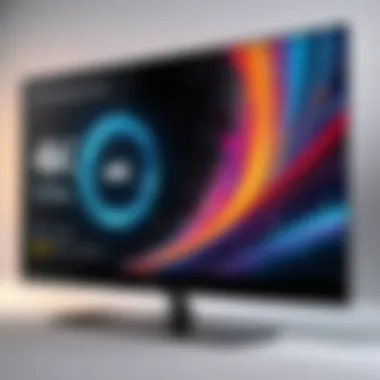Understanding 4K 120Hz TVs: Complete Buyers Guide


Intro
The evolving landscape of television technology has led to a surge in demand for high-resolution displays. Among them, 4K 120Hz TVs stand out for their impressive picture quality and smooth motion performance. This section serves as an overview of these advanced televisions. As consumers become more discerning, understanding the benefits and features of such products becomes essential.
Overview of the Product
Purpose and Benefits
4K resolution offers a significant upgrade over the previous standards, providing four times the pixel count. This clarity allows for a more immersive viewing experience. The 120Hz refresh rate complements this by reducing motion blur and providing a smoother image, which is particularly beneficial for fast-paced content like sports and video games. Ultimately, these televisions cater to those seeking enhanced detail and fluidity in their viewing experience.
Target Audience
The target audience includes tech enthusiasts, gamers, and anyone looking to enhance their home entertainment setup. Gamers will appreciate the low input lag and high responsiveness, while movie buffs will benefit from the vivid colors and detail that 4K provides. General consumers also find these televisions appealing due to their versatility for both streaming and regular viewing habits.
Key Features
A few standout features of 4K 120Hz TVs help distinguish them in the crowded TV market:
- Exceptional Picture Quality: High pixel resolution combined with excellent color accuracy.
- High Refresh Rate: Capable of rendering fast-moving scenes without blurring.
- Gaming Features: Support for features like Variable Refresh Rate (VRR) and Automatic Low Latency Mode (ALLM).
- Smart Capabilities: Access to a variety of applications for streaming and gaming platforms.
Intro to 4K 120Hz TVs
The advent of 4K 120Hz TVs marks a significant milestone in visual technology. This section addresses the essential components that make these televisions a compelling choice for consumers. From enhanced picture clarity to smoother motion performance, the importance of understanding 4K 120Hz TVs is paramount, particularly for tech enthusiasts and gamers.
Defining 4K Resolution
4K resolution, often referred to as Ultra High Definition (UHD), consists of a display resolution of 3840 x 2160 pixels. This resolution delivers four times the pixel density of Full HD (1920 x 1080 pixels). The increase in pixel count allows for more detailed and sharper images. For viewers, this means a clearer representation of finer details in movies, video games, and sports broadcasts.
Key Points about 4K Resolution:
- Higher Pixel Count: Offers sharper images.
- Enhanced Color Depth: Often paired with High Dynamic Range (HDR) for richer colors.
- Future-Ready: As content becomes more available in 4K, having a compatible TV ensures one is prepared for the future of viewing.
Understanding 120Hz Refresh Rate
The refresh rate of a TV measures how many times the image on the screen is updated per second, expressed in hertz (Hz). A 120Hz refresh rate means the TV refreshes the picture 120 times every second. This capability is particularly beneficial for fast-paced content such as video games or sports programming.
Benefits of a 120Hz Refresh Rate:
- Reduced Motion Blur: Presents smoother visuals during fast-moving scenes, critical for gamers and sports enthusiasts.
- Better Game Responsiveness: Enhanced performance for gaming, leading to an improved overall experience.
- Compatibility with High Frame Rate Content: Supports newer video games and films that utilize high frame rates.
In Summary: Understanding 4K resolution and 120Hz refresh rates is crucial for anyone looking to enhance their viewing experience. These technologies work together to provide both clarity and smoothness, catering particularly to the demands of today’s media consumers.
The Technology Behind 4K 120Hz TVs
The technology behind 4K 120Hz TVs is fundamental, as it influences viewing experiences and enhances performance. Understanding these technologies can help consumers make better decisions about their purchases. Factors such as display technology and HDR (High Dynamic Range) play a significant role in a TV's performance. By grasping the details of these elements, one can better appreciate what makes each type of TV unique and suitable for certain applications, especially gaming and home theater setups.


Display Technology Overview
OLED
OLED, or Organic Light Emitting Diode, is known for its excellent contrast ratios and color accuracy. Each pixel in an OLED display emits its light, allowing for true blacks and excellent color reproduction. This characteristic makes OLED a preferred option for many viewers who prioritize picture quality. However, one limiting factor can be screen burn-in, where static images persist on the screen, affecting long-term durability. Overall, OLED offers superior viewing experiences, especially in dark environments.
QLED
QLED, or Quantum Dot Light Emitting Diode, enhances color and brightness through the use of quantum dots, which are tiny particles. This technology allows QLED TVs to reach higher brightness levels than OLEDs. Consequently, these TVs perform particularly well in brightly lit environments, making them a beneficial choice for daytime viewing. Nonetheless, QLED screens can struggle with blacks compared to OLED, as they rely on backlighting, which can cause less than ideal contrast in dark scenes.
LCD, or Liquid Crystal Display, remains a common technology for many TVs.
The technology behind LCDs is simple and effective. LCDs utilize liquid crystals, which are aligned by electric currents to manipulate light from a backlight. While LCDs are typically less expensive than OLED and QLED options, their performance can vary greatly. One appealing characteristic is their lower price point, making them an attractive option for budget-conscious consumers. However, they often lack the deep blacks and vibrant colors that OLED and QLED can deliver.
HDR and Its Importance
HDR, or High Dynamic Range, is crucial for enhancing visual quality in 4K 120Hz TVs. It boosts the contrast between the darkest and brightest parts of an image. This technology provides a fuller range of colors, allowing viewers to experience more lifelike images. HDR is particularly beneficial for cinematic content, as it replicates the motion picture's intent with greater fidelity. Several HDR standards exist, with HDR10, Dolby Vision, and HLG being the most recognized. Each offers various enhancements that can significantly impact the viewing experience, especially in dynamic scenes where color depth and brightness change rapidly.
In summary, understanding the technology behind 4K 120Hz TVs reveals significant insights into their functionality and user experience. Technologies like OLED, QLED, and HDR are key players in shaping modern viewing standards.
Key Features of 4K 120Hz TVs
Understanding the key features of 4K 120Hz TVs is essential to appreciate their advantages and overall impact on viewing experiences. These features drive the performance and satisfaction for consumers, especially for those who enjoy gaming or high-definition media consumption.
Input Lag and Gaming Performance
Input lag is the delay between a user’s action on a device, like a console, and the visual response on the screen. For serious gamers, low input lag is a significant factor, as it directly affects gameplay fluidity. A 4K 120Hz TV typically delivers faster response times compared to lower refresh rate alternatives. This results in smoother transitions and improved responsiveness during fast-paced gaming.
To gauge input lag effectively, it's pivotal to consider the specifications of the TV. Many models tout input lag as low as 10 milliseconds. This quick response time creates a competitive edge in gaming, particularly in first-person shooters and other genres where split-second decisions matter. Plus, higher refresh rates also help ensure that motion blur is minimal, allowing for a clearer visual experience.
Variable Refresh Rate Technologies
Variable Refresh Rate (VRR) technologies are essential features that enhance the gaming experience on 4K 120Hz TVs. By adjusting the TV's refresh rate to match the output frame rate of the gaming console or PC, VRR helps minimize screen tearing and stuttering.
G-SYNC
G-SYNC is a technology developed by NVIDIA designed to deliver a smoother gaming experience. It does this through dynamic refresh rate adjustments that sync the display to the video output. This match ensures that frames are displayed as soon as they are rendered, eliminating any potential lag that may occur.
The key characteristic of G-SYNC is its ability to solve the common issue of screen tearing. For many gamers, this makes it a popular choice. One unique feature is its support for a wide range of refresh rates, which means even if the frame rate drops below the monitor’s minimum refreshing capability, G-SYNC can still provide a fluid performance.
However, G-SYNC can be subject to some disadvantages. It is typically more expensive than other technologies like FreeSync, mainly because it requires specific hardware configurations.
FreeSync
FreeSync, created by AMD, functions similarly to G-SYNC but varies in implementation. This technology is widely appreciated for being more accessible since many FreeSync-compatible displays do not require special hardware. FreeSync adjusts the refresh rate of the monitor to match the frame rate of the graphics card.
The key characteristic of FreeSync is its affordability and broad compatibility with various supports. This makes it a beneficial choice for gamers who may not want to invest heavily in higher-end models. A unique feature of FreeSync is that it can operate across a large range of frame rates. However, it may lack some of the seamless quality that G-SYNC provides, as not every model can fully synchronize at all refresh ranges.


Pros and Cons of 4K 120Hz TVs
The conversation around 4K 120Hz TVs often includes both praise and criticism. Understanding these pros and cons is essential for anyone considering an upgrade to this technology. This section will unfold significant benefits and potential limitations of 4K 120Hz TVs, helping readers make informed choices for their viewing experiences.
Advantages of 4K 120Hz TVs
4K 120Hz TVs bring several crucial advantages to the table, particularly for specific user needs.
- Stunning Picture Quality: With 4K resolution, these TVs offer four times the pixel density compared to standard 1080p. Each image contains details that are crisp and vibrant, enhancing the overall viewing experience.
- Smooth Motion: The 120Hz refresh rate delivers smooth motion, which is particularly beneficial during fast-paced action scenes in movies or competitive gaming. This helps reduce motion blur, allowing viewers to enjoy more clarity and realism.
- Gaming Experience: For gamers, the combination of 4K resolution and a high refresh rate is a game-changer. Consoles like the PlayStation 5 and Xbox Series X support this technology, allowing gamers to experience smoother gameplay without lag.
- Future-Proofing: Investing in a 4K 120Hz TV can be seen as future-proofing your entertainment setup. As content production continually shifts towards higher resolutions and refresh rates, owning a capable TV ensures compatibility with future offerings.
Potential Drawbacks
Despite their advantages, 4K 120Hz TVs have some drawbacks that consumers should consider.
- Cost Factor: One of the most significant concerns is the price. These TVs tend to be more expensive than their lower resolution counterparts. For some consumers, the added expense may not be justifiable.
- Limited Content Availability: Although some video games and select movies support 4K 120Hz, the overall content library is still limited. Viewers may not find a wide array of options to fully utilize their TV’s capabilities right now.
- Need for Best Equipment: To get the most out of a 4K 120Hz experience, users often need high-end HDMI cables and compatible devices. The standard equipment may not suffice, leading to additional costs.
Understanding these dynamics is crucial for both tech enthusiasts and casual viewers alike. The right choice reflects not only personal viewing habits but also how one navigates this evolving landscape of entertainment technology.
Evaluating the Best 4K 120Hz TVs
Evaluating the best 4K 120Hz TVs is crucial for consumers who want to maximize their viewing experience. This analysis helps buyers identify options that cater to their specific needs, whether that's gaming, streaming, or general use. In the world of 4K, not all TVs are created equal. An informed choice can lead to enhanced performance and satisfaction, especially when considering factors like display technology, features, and brand reputation. Understanding these elements guides consumers towards the most suitable options in a crowded market.
Top Brands in the Market
Sony
Sony has a strong reputation for its quality displays and innovative features. The key characteristic of Sony TVs is their superior image processing technology, which enhances color accuracy and picture clarity. This makes Sony a popular choice for those who prioritize visual fidelity in their home viewing experience. A unique feature of some of their models is the Cognitive Processor XR, which analyzes content and optimizes it for maximum impact. This advantage lies in its ability to provide a remarkably realistic picture, though the price point can be a disadvantage for budget-conscious consumers.
Samsung
Samsung is renowned for its diverse range of 4K TVs featuring QLED technology. The vibrant colors and impressive brightness of Samsung screens make them stand out. The Quantum Dot technology in Samsung's TVs allows for a wider color spectrum, making it an excellent choice for bright rooms. One unique feature found in many Samsung models is the Motion Rate technology, enhancing motion clarity during fast-paced scenes. However, some consumers might find their smart TV interface a bit overwhelming at first.
LG
LG has made significant strides with their OLED technology, delivering astonishing contrasts and deep blacks. The core characteristic of LG TVs is the excellent viewing angles, allowing for a consistent picture from various positions in a room. They have integrated features like AI Picture Pro to optimize images based on the environment. While the price of LG OLED models may be higher than others, the visual performance often justifies the investment.
Vizio
Vizio is recognized for providing excellent value while maintaining performance. The key characteristic of Vizio TVs is their affordability coupled with respectable image quality through their Quantum Color technology. This makes Vizio a beneficial choice for those looking for quality without spending excessively. One of their unique features includes the Smartcast platform, which gives users seamless access to popular streaming services. However, some users may find the initial set-up process a bit complicated compared to other brands.
Product Recommendations
Best for Gaming
When it comes to gaming, selecting the best option often hinges on features like low input lag and support for Variable Refresh Rate technologies. The key characteristic of the best gaming TVs is that they provide smooth gameplay with minimal interruptions. A notable feature for gamers is Auto Low Latency Mode, which automatically optimizes settings when a console is detected. However, gamers need to ensure that the selected model has enough HDMI 2.1 ports for next-gen console connectivity.
Best for Streaming


The best TV for streaming requires a robust smart platform and support for various streaming resolutions. This recommendation often highlights TVs that boast strong app support and user-friendly features. The unique feature in this category may be advanced upscaling capabilities, which allow lower resolution content to appear clearer. Cost can pose a disadvantage if someone is specifically looking for high-end support.
Best Overall Performance
With a focus on overall performance, the best all-around 4K 120Hz TV needs to excel in brightness, color gamut, and smart features. Its key characteristic is the ability to offer great visual experiences across multiple content types. Unique features could include exceptional audio systems integrated within the TV, but potential downsides may include a higher price tag compared to lesser-known brands.
Choosing the right 4K 120Hz TV involves balancing performance with personal needs such as content type and budget. Evaluating options carefully can ensure satisfaction with the purchase.
Compatibility and Connectivity
Compatibility and connectivity are foundational elements when considering a 4K 120Hz TV. As technology advances, having a device that properly integrates with other home entertainment components is crucial. This section highlights important aspects of compatibility and connectivity, including what makes them essential for an enjoyable viewing experience.
HDMI Standards Explained
HDMI (High-Definition Multimedia Interface) is the standard for connecting video and audio devices. For 4K 120Hz TVs, understanding different HDMI standards is vital. The latest version, HDMI 2.1, supports higher resolutions and refresh rates.
Key Features of HDMI 2.
1:
- 4K at 120Hz: Allows for smooth playback of fast-moving scenes.
- Enhanced Audio Return Channel (eARC): Simplifies connection with sound systems or soundbars.
- Variable Refresh Rate (VRR): Reduces screen tearing in gaming.
Newer HDMI cables are necessary to take full advantage of these features. Look for Ultra High Speed HDMI cables. These cables are certified to support the demands of 4K 120Hz content.
Other Connectivity Options
Apart from HDMI connections, various other options are available for connecting devices to a 4K 120Hz TV. These include Optical Audio, USB ports, and wireless connections.
Common Connectivity Options:
- Optical Audio: Transmits high-quality audio from TV to sound systems.
- USB Ports: Useful for streaming content from flash drives.
- Wi-Fi and Bluetooth: Enable seamless streaming from mobile devices and support for wireless speakers.
By understanding these connectivity options, users can ensure their 4K 120Hz TV communicates effectively with all their devices.
Compatibility impacts not only the visual quality but also the overall experience of using a 4K 120Hz TV. Choosing the right connections enhances the viewing experience significantly.
Finale: Making an Informed Purchase
The realm of 4K 120Hz TVs offers significant advancements in video quality and viewing experience. Making an informed purchase is crucial. It allows consumers to navigate the complexities of various features and specifications that define these televisions. By understanding the various elements covered throughout this article, buyers can better assess their needs against the available options in the market.
Final Thoughts on 4K 120Hz TVs
4K 120Hz TVs represent the pinnacle of home entertainment technology. They provide sharp images and smoother motion, making them desirable for gaming and watching movies. As the tech landscape evolves, enhancements in resolution and refresh rates continue to emerge. It is essential to remember that while the numbers seem impressive, actual performance can differ depending on how the technology is implemented.
"In the rapidly changing world of technology, making an educated decision can enhance your enjoyment of home media systems."
Tips for Choosing the Right TV
When exploring choices in this category, consider these aspects:
- Purpose of Use: Identify what you will primarily use the TV for, whether it is gaming, streaming, or general viewing.
- Viewing Distance: A larger screen may be favorable for more distance but could need careful placement in smaller rooms.
- Refresh Rate vs. Performance: Look beyond just the 120Hz label. Ensure the TV performs well under various conditions.
- Connectivity Options: Verify compatible ports and connection features for future devices you plan to integrate.
Reviewing these elements will lead to a decision that aligns with your preferences and enhances your viewing experience. Whether you're a gamer seeking performance or a casual viewer wanting clarity, an informed choice will meet your unique requirements.



